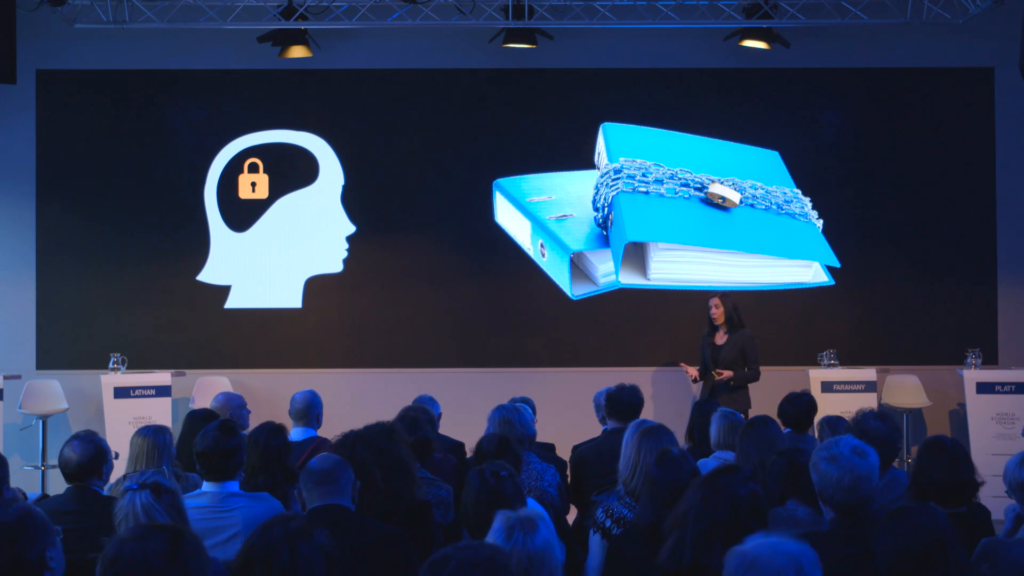Nita Farahany: What if we lived in a world of total transparency? If even what you’re thinking right now is something that you could know, that I could know, and that we all could see. The average person (not that any of you are average) thinks about 70,000 thoughts per day. And as you think those thoughts, patterns of electrical activity can be detected from your brain as neurons fire and let off tiny electrical discharges. And those tiny electrical discharges can be measured, visualized, and decoded. And with sophisticated algorithms, we can start understand what those mean. Whether it’s a thought that you’re having. Whether it’s a state of arousal. Whether you’re drowsy while you’re driving.
In fact what you’re seeing right now is real-time brain activity of two people who are here in the audience. You’re seeing the visualization, of literally in real-time, brain activity in various regions of the brain being measured through a simple consumer-based EEG device that all of you now have access to.
On the right-hand side—or your left, my right—you see a flower. Which hopefully will grow soon. There we go. And the way that flower’s being grown is again through a simple EEG device that one of the participants in the audience is thinking. Which means we know that when the flower opens that what he’s thinking is “grow.” And we’ve been able to decode that now through a simple-consumer based EEG device such that we can literally see what he’s thinking.
Now, we’re not yet at the point where what all of you are thinking right now is something that like a little thought bubble above your head is something that we can see. But we’re getting there. We’re getting to the point where there is transparency of thought, of emotion, of feeling. And that has terrific promise.
You heard our last speaker talk about brain health, the ability to have in your very own hands, in your very own home, the possibility of seeing your brain activity, decoding it, training it, as something you can do now, today. And that has great promise not just for health but for self-access and self-knowledge. Your ability to know your emotions, to get a better handle on them. To understand how you react in various situations and to be able to change it. If you’re an epileptic you could know, before you have an epileptic seizure. If you are a person who’s a diabetic, you could know before you go into insulin shock simply by monitoring your brain activity in real time. That is incredibly exciting.
But you might be wondering how it is that you’re seeing these on the screen right now. So, I going to invite both Tan and [Steve?] to come up on the stage, who are wearing these consumer-based devices. Tan is actually the CEO of the company of the device that we’re actually looking at, which is EMOTIV’s EEG device. And we’re seeing their activity in real-time, which is really exciting.
Now, you might be wondering how we’re doing it. It’s because these are communicating via Bluetooth technology to the iPad, and to the computer in the back of the room. And one of the things that’s remarkable about this technology is Bluetooth is not necessarily the most secure channel. Which means a hacker might be able to hack into and gain access to information about what’s happening in their brains right now. Which means that the NSA and other organizations can spy not just on your email and your cell phones, but soon potentially on your brains as well. Thank you both for letting us spy on your brains for this simple presentation.
Any technology in the wrong hands could be problematic. But, what these technologies promise us are so extraordinary that I believe that they’re going to become quite mainstream. I believe it’s something that we, just like many of you may be wearing fitness trackers right now, that we’ll start to use and that we’ll start to embrace as a society. And that comes with great promise but also with ethical and legal perils. It requires that we think about what the world may look like as even the last bastion of freedom and privacy suddenly becomes more transparent.
We as a society have to decide whether or not the ability to access and change our brains is something that we want, that we’re going to embrace, or something that we’re going to put limits on. These devices are one-way devices. Meaning perhaps you could be hacked into, in a way, simply by listening to what’s happening in your brain. But there won’t be any changes to what’s happening in your brain. And yet we can also change our brains right now, too. You could change your brains using neurofeedback with these devices, but you also could change your brains in other ways, like drugs and devices that give little shocks to your brain.
How many of you had a cup of coffee today? That’s a cognitive enhancer, right? And it’s one that we’ve come as a society to embrace. But in other contexts, like in sports, we think revving up your body through the use of steroids or other forms of doping is cheating. Consider the fall from grace of Lance Armstrong, who when it was discovered the types of measures that he took to enhance his performance, went from one of the greatest athletes of our time, that we celebrated, to one that we question, to one that we think no longer represents that pinnacle of honed, raw talent.
Do we feel the same way about our brains? Is it the same thing that if we’re taking different drugs or devices, we’re somehow less natural? We somehow are less human? That we’re cheating? Or is that really the point of why we’re all here? Is the very idea of being a human, honing our abilities, improving our cognition, enabling us to be the best possible version of what we can be?
This is Hobbie-J. Hobbie-J may not be smarter than you, but he is smarter than the smartest of the Long-Evans rats. And the reason Hobbie-J is so smart is because he’s been transgenically modified to increase the receptors in his brain that enable him to remember things better. And that is terrifically promising not just for Hobbie-J but for humans, because the targets in Hobbie-J that turn out to be useful to enhance his memory are also great drug targets for improving memory in humans. And that’s incredibly promising for Alzheimer’s patients and others who suffer memory loss. But since I saw most of you raise your hand and say that you’ve lost your keys or forgotten names…it also might be tempting for you to take a memory-boosting or -enhancing drug.
And it’s certainly tempting for a college student studying for an exam to be able to remember things better. Is it cheating if they get an advantage relative to their peers by being able to take a drug? If it is, are there limits that we wish to put on it, and how would we possibly differentiate between the drugs for improving memory and the coffee that you all drank this morning that improved your ability to be awake and to process information?
There’s a different drug whose name you probably may be familiar with already. And if you’re not you may want to write down, because I think it’s a fantastic drug. It’s called modafinil. You might know it as Provigil instead. Provigil turns out to be incredibly powerful as a cognitive enhancer. It was first tested on Air Force pilots, and there were some remarkable results. They were trying to improve their wakefulness, because you might hope that an Air Force pilot is somebody who’s able to remain awake and have sophisticated motor skills even when they suffer from sleep deprivation.
What we found in Air Force pilots was when they took the drug, even after not having any sleep for seventy-two hours they performed better than people who had had seven hours of sleep per night on motor performance IQ tests. But, they also did just as well if not better on performance IQ tests, not just motor IQ tests. And yet this is a drug that worldwide is significantly limited. Because we haven’t yet figured out how we actually assess the risks and benefits of enhancement drugs. The traditional model of safety and efficacy doesn’t work as we think about these types of drugs and devices, and we’re going to have to fundamentally change the way we think about things to enable you to make a choice as to whether or not you want to take the drug. To make the choice as to whether or not we as a society will embrace these types of devices, these types of drugs.
But we have to ask, as we’re able to change our brains, as we’re able to access our brains, as we’re able to speed them up and slow them down, improve our memory, improve our wakefulness, detect what’s happening there, detect what’s happening in others’ brains, if there’s some space of mental privacy. Privacy is something that seems to be gone. Big data and an era of big data, we seem to have lost any sense that there is any aspect our lives that can’t be analyzed and that big data can’t be collected about. Is that true for our brains? Does the UN charter on human rights protect something like freedom of thought? Freedom of speech is something we’ve traditionally protected but what about when we can get to your thoughts. Should we, as a global community, start to think about protections for our brains or should we embrace a society of truly total transparency?
And, we have to ask whether or not we’re going to give people access to information about themselves. In the US, the company 23andMe is a direct-to-consumer genetic testing company that was shut down in part for a while when the Food and Drug Administration decided that the information that they were giving to individuals was potentially dangerous. And if you look through the reasons why, a lot of it was based on a paternalistic notion of what is dangerous. That we have to go through a gatekeeper to get information about ourselves because we’re not sophisticated enough to have access to information about ourselves.
Will they decide that about drugs, and devices, and consumer-based EEG devices? Worldwide we’re starting to look around regulations of those issues. Will that slow progress down in brain health and access to ourselves? We have to decide, as a global community, how we’re going to approach these issues. The promises of brain science are extraordinary. The promises of being able to access your own brain, change your own brain, and even potentially access the brains of others is extraordinarily exciting. What we can do as we start to harness what has traditionally been in the black box of our brains is incredibly terrific. But it’s also a little bit terrifying. Thank you.




